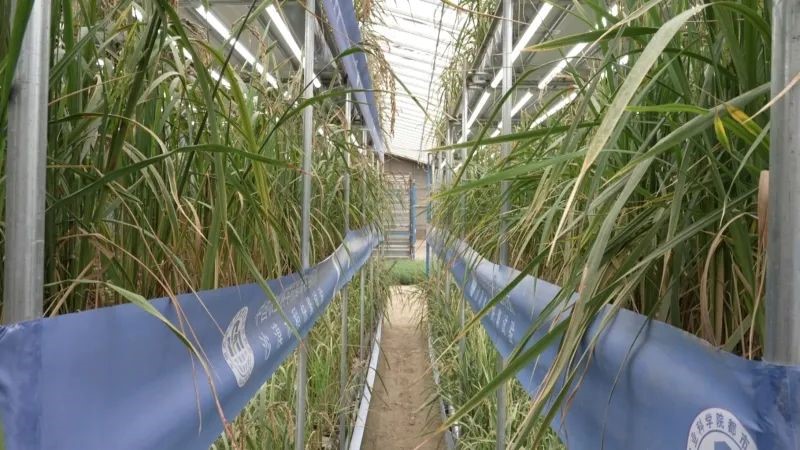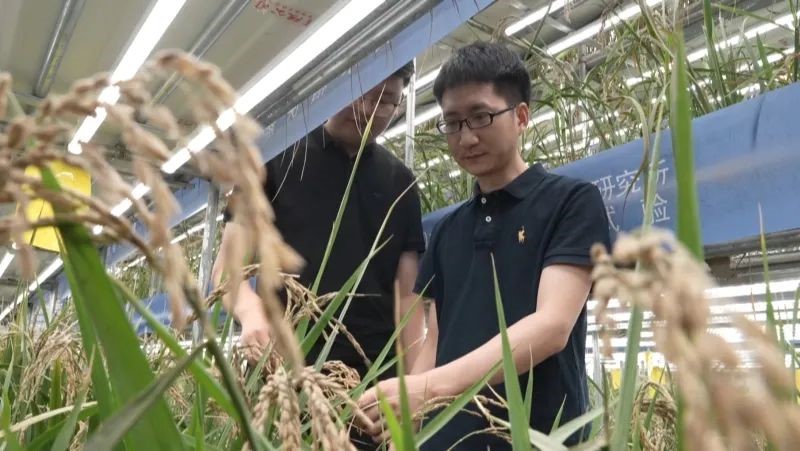




- BRNN
- BRI News
- BRNN News
- Database
Official Documents Polices and Regulations
Inter-government Documents International Cooperation BRI Countries
Business Guide Economic Data BRI Data
Trade
Investment Projects Latest projects
Cases - Content Pool
Amid the sprawling desert of Hotan prefecture, northwest China's Xinjiang Uygur autonomous region, greenhouses spread across vast expanses, providing abundant light and heat resources for the growing crops.
These greenhouses are within a plant factory of an agricultural industrial park. Here, the soilless cultivation has been made possible by three-layer frames, which provide a vertical space for the rice seedlings to grow, leading to a significant increase in the per-unit yield.

Rice thrives at a speed breeding base of the Chinese Academy of Agricultural Sciences (CAAS) in Hotan prefecture, northwest China's Xinjiang Uygur autonomous region. (Photo courtesy of the media center of Hotan prefecture)
With this cultivating technology, it takes just 60 days for the rice seedlings to harvest, a remarkable improvement compared to ordinary farming practices that usually take 120 to 150 days on average for rice to mature in China.
"We used a local rice variety for this cultivation by taking fast breeding technology," said Wang Sen, a researcher with the Institute of Urban Agriculture (IUA) of the Chinese Academy of Agricultural Sciences, adding that the seedling cultivation took 15 days, and the entire production cycle is 60 days by far.
The significant reduction of the rice growth cycle was accomplished by the research team led by Yang Qichang, chief scientist with the IUA. By adopting the speed breeding technology, the team has not only cut the growth cycle of rice by half, but allowed rice to be cultivated throughout the year, without being limited by seasonal factors.
The plant factory is equipped with numerous LED lights, which are indispensable for speed breeding. According to Shi Dawei, a member of Yang's team, the team has managed to adjust the lighting conditions to meet the photosynthesis needs at different stages of rice cultivation, thereby achieving precise lighting and a shortened rice growth cycle.

Researchers with the Institute of Urban Agriculture (IUA) of the Chinese Academy of Agricultural Sciences (CAAS) observe the rice growth at a speed breeding base in Hotan prefecture, northwest China's Xinjiang Uygur autonomous region. (Photo courtesy of the media center of Hotan prefecture)
Yang said that the plant factory can control temperature, humidity, lighting, carbon dioxide, and nutrition in the root zone of the rice. In April 2024, the factory harvested the first batch of rice using speed breeding technology, achieving a yield of 1,051.5 kilograms per mu (about 667 square meters). Since May, two more batches of the same rice variety have been harvested, both yielding over 1,000 kg per mu. Currently, the fourth batch of rice seedlings is being cultivated.
"We plan to further enhance grain production with the greenhouses and other new technologies in the Gobi Desert. With the potential to harvest five batches of rice annually, we could increase the yield to approximately 5,000 kg per mu every year, thereby contributing to food security," said Yang.
The research team has also adopted a three-dimensional seedling cultivation machine that keeps rotating to ensure ample sunlight and even growth of each seedling, according to Yang Jun, another member of Yang's team.
"The seedlings can mature in 15 days. Covering about 10 square meters, a single machine can provide seedlings for 50 mu of land," he said.

Photo shows greenhouses in Hotan prefecture, northwest China's Xinjiang Uygur autonomous region. (Photo courtesy of the media center of Hotan prefecture)
Hotan is an ideal place for experimentation and building greenhouses because the land costs are relatively low here with its vast deserts, abundant sunlight and heat resources. "We can make the most of natural light and accumulate heat without relying on coal heating to control temperature," Yang said.
After more than two years of trial planting, Yang's team has successfully addressed the main obstacles to speed breeding in desert greenhouses.
"The building cost of these efficient and energy-saving desert greenhouses is approximately 350 yuan (about $49.19) per square meter. The use of technologies such as new energy, machinery, and smart equipment will help to further reduce the costs," said Yang Qichang.
The agricultural industrial park in Hotan has four plant factories. In addition to rice, other crops such as corn, tomatoes, and pepino melons are also cultivated here. Currently, Yang and his team are working on key technologies for speed breeding of staple crops like soybeans, corn, and wheat, as well as rapeseed, cotton, and alfalfa. Their goal is to provide technological support for speed breeding and efficient production of greenhouse crops.

Tel:86-10-65363107, 86-10-65368220, 86-10-65363106